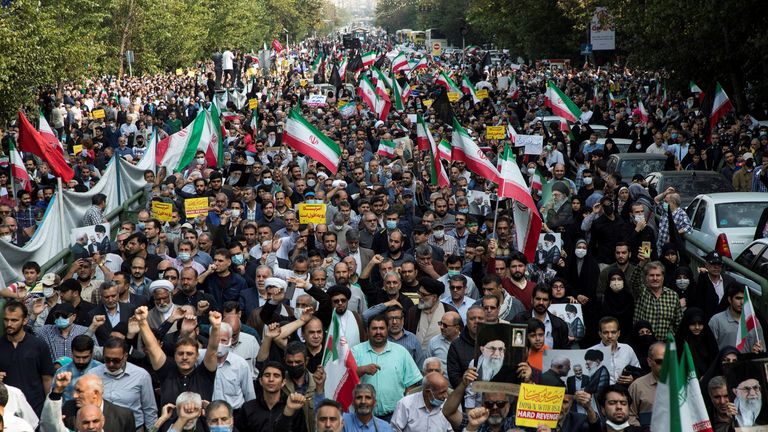Iran’s supreme leader Ayatollah Ali Khamenei has the final say on all major policies, serves as commander-in-chief of the armed forces and controls the Revolutionary Guard.
Mr Khamenei was born into a clerical family in 1939 in Iran’s second-largest city Mashhad.
He received a religious education there before turning his attention to political activities against the Shah – the country’s royal ruler until the 1979 Iranian Revolution.
Middle East latest: ‘Widespread panic’ in Lebanon
Mr Khamenei eventually went into exile in the 1960s, only re-emerging after the Shah was overthrown.
He was a close confidante of the leader who emerged after the revolution – Ayatollah Ruhollah Khomeini – and Mr Khamenei quickly rose through the ranks of government.
After other key political figures were assassinated – with Mr Khamenei himself targeted in a separate attempt, leaving him paralysed in his right arm – he became president of Iran in an uncontested election.
He eventually succeeded Khomeini after his death in 1989, becoming supreme leader.
Mr Khamenei was appointed by the 88-person Assembly of Experts, whose members are elected but vetted by the 12-person Guardian Council – of which Mr Khamenei appoints six members.
The Guardian Council, a clerical body, also vets candidates for presidential and parliamentary elections.
In theory, the council oversees the republic to ensure it complies with Islamic law.
In reality, the supreme leader carefully manages the existing system to balance competing interests, advance his own priorities and ensure that no one challenges the Islamic Republic or his leadership.
Read more:
Khamenei warns Israel attack ‘will be done again if necessary’
The aftermath of strikes in Israel and Lebanon
Where the Iranian missiles struck Israel
His 35-year reign over Iran also means his influence extends across the Middle East, given Iran’s backing of Hamas and Hezbollah.
Despite Mr Khamenei’s overarching power in Iran, he faces issues domestically as well as being one of the most consequential figures in the ongoing crisis in the Middle East.
👉 Click to subscribe to the Sky News Daily wherever you get your podcasts 👈
The death of Ebrahim Raisi, Iran’s president, in a helicopter crash in May posed a major issue for the supreme leader.
Mr Raisi was replaced by Masoud Pezeshkian as Iran’s president following his death.
Mr Raisi had been seen as the main candidate to succeed the 85-year-old Mr Khamenei.
His death meant that Mr Khamenei’s son was more likely to become the successor.
The Republic was founded as an alternative to a monarchy after the 1979 Revolution, with leaders portraying their system as superior to both Western democracies and military dictatorships and monarchies across the Middle East.
However, many Iranians already view the state as a corrupt and dictatorial regime, which would be further highlighted by Khamenei’s possible choice of successor.
This isn’t the only reason some Iranians are unhappy with his leadership. Western sanctions linked to the country’s nuclear programme have devastated its economy.
And perhaps the biggest threat to his rule, the enforcement of strict Islamic laws – which have grown more severe in recent years – has alienated women and young people.
The republic has seen several waves of popular protests in recent years, most recently after the 2022 death of Mahsa Amini, who had been arrested for allegedly not covering her hair in public.
More than 500 people were killed and 22,000 detained by state forces in a violent crackdown against the protests.




